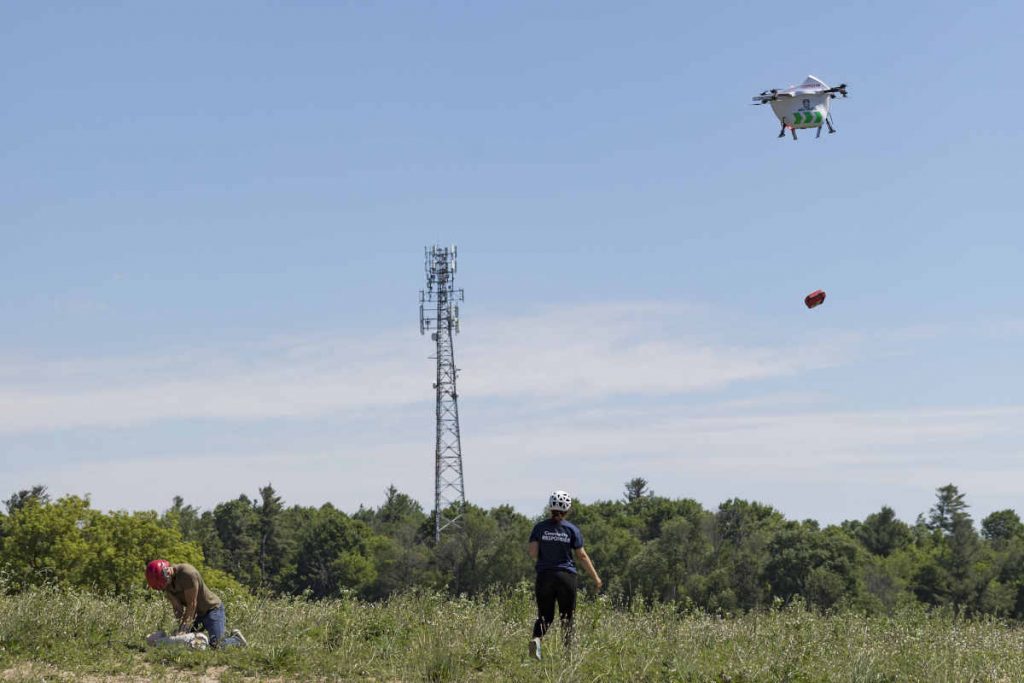
News
Emergency Services
DDC completes phase two of defibrillator-delivery project
“We were able to markedly improve the speed of drone descent, the ability to accurately drop a protected AED from a drone at a safe height but most importantly see first-hand the benefits of technology that guides the first responder through the application.”
July 9, 2020 By UAV Canada Staff
 Drone Delivery Canada’s Sparrow Drone releasing an Automated External Defibrillator. (Photo: CNW Group, Drone Delivery Canada)
Drone Delivery Canada’s Sparrow Drone releasing an Automated External Defibrillator. (Photo: CNW Group, Drone Delivery Canada) Drone Delivery Canada Corp. on June 26, 2020, completed Phase Two of the AED On The Fly project with Peel Region Paramedics and Sunnybrook Centre for Prehospital Medicine to delivery Automated External Defibrillators (AED). The study overall focuses on demonstrating the use of Drone Delivery Canada’s (DDC) AED drone solution with community responders in a simulated cardiac arrest scenario. The testing is designed to validate how the drone delivery platform with cargo drop functionality can reduce response time to cardiac arrest patients in the field while being utilized by lay responders.
“This partnership between DDC, Peel Regional Paramedic Services and Sunnybrook Centre for Prehospital Medicine is groundbreaking,” said Michael Zahra, president and CEO of Drone Delivery Canada. “This innovative program utilizes DDC’s proprietary drone logistics platform to deliver rapid first responder technology via DDC’s Sparrow drone with the goal to reduce response time and potentially save lives.”
More specifically, Phase Two utilized the Sparrow drone with a new cargo drop capability and a new audio announcement system to drop an AED where a designated lay bystander would then retrieve the AED and apply it to a simulated cardiac arrest patient in a rural environment. DDC explains multiple pairs of lay bystanders and simulated cardiac arrest patients in multiple locations were used to test the AED drone solution. Response time to drop, retrieve and apply an AED, and physiological and psychological human factors in a stressful situation were measured during the testing.
“Phase Two of our research was truly a success. Our previous research within our rural community suggested the need to optimize the simplicity of AED use once delivered by a drone to the site of a cardiac arrest,” said Dr. Sheldon Cheskes, an associate professor at the Department of Family and Community Medicine, University of Toronto and the principal investigator of the AED On The Fly pilot research program. “Today we were able to markedly improve the speed of drone descent, the ability to accurately drop a protected AED from a drone at a safe height but most importantly see first-hand the benefits of technology that guides the first responder through the application of an AED after being released by the drone in a simulated cardiac arrest scenario.
“All these factors strengthen the likelihood that not only may drones decrease time to first AED shock in rural and remote communities but the fear of AED use can be minimized by real time interaction between a first responder and trained personnel demystifying the use of AEDs during cardiac arrest,” continued Cheskes, who also thanked Cardiac Arrhythmia Network of Canada (CANet) and Zoll Medical Inc. of Chelmsford, Massachusetts, for funding the project. “After today’s test flights it will not take long to see drones as part of an organized 911 response to cardiac arrest in rural communities.”
Print this page